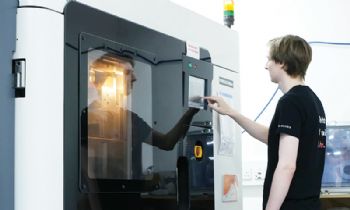
Yorkshire-based Fluxaxis, which offers large-scale 3-D printing, 3-D scanning and finishing services from its facility in Tockwith, has recently used fused deposition modelling (FDM) technology to produce a huge ‘David and Goliath’ sculpture for renowned artist Jam Sutton.
The company (
www.fluaxis.com) regularly works on large sculptures for stadia and public spaces, but this is one of its largest so far.
Part of an exhibition that was shown recently at Dublin Castle, the 3-D printed replica of the original marble sculpture was produced in three parts and took 258hr to print (using 15kg of material).
It was made possible by Stratasys Fortus 900mc additive-manufacturing system supplied to Fluxaxis by Derby-based SYS Systems (
www.sys-uk.com).
Production manager Jake Augur said: “The sculpture had David standing on Goliath’s head, printed all in black and then painted pink.
It was a 1,200mm-high sculpture in ASA (acrylonitrile styrene acrylate), done on the Fortus 900mc, which is the main workhorse for us; we also have a Fortus 250 for smaller and quick-turnround jobs.
The capacity of the 900 really invites us to see how big we can go with Fused Deposition Modelling.”
Pioneered by Stratasys 30 years ago (
www.stratasys.com), FDM is widely regarded as the spark that ignited the 3-D printing revolution, and it continues to ‘open doors’ for manufacturers, designers, engineers, educators and other professionals.
It works by building parts layer by layer from the bottom up, through heating and depositing thermoplastic filament.
It uses the same tried and tested thermoplastics found in traditional (but more time-consuming) manufacturing processes, so it delivers for applications that demand tight tolerances, toughness and environmental stability, or ones with specialised properties like electrostatic dissipation, translucence and biocompatibility.
Mr Augur said: “The F900 can produce parts that are both large and highly detailed in a multitude of layouts and a multitude of materials, and FDM is really the king of all 3-D printing processes.
“There is no other process which is safer, and both Fortus machines are so reliable.”